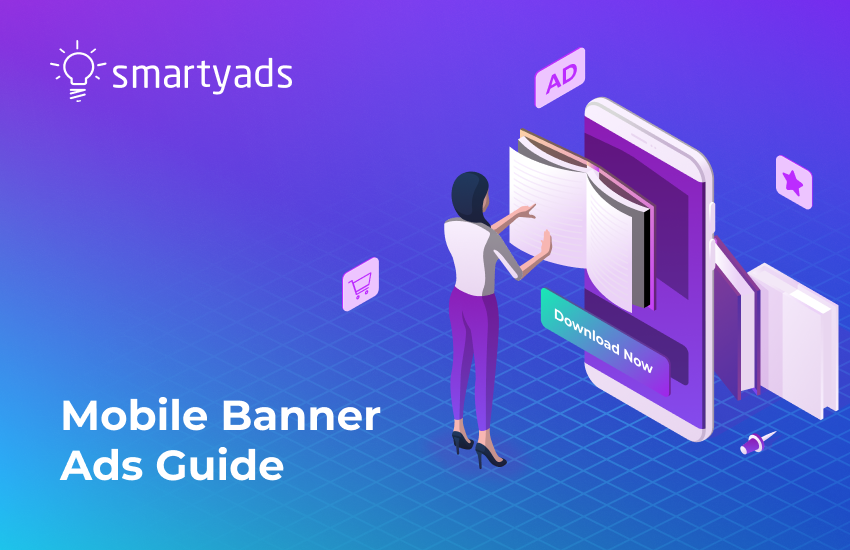Mobile advertising is the leading form of advertising today, as each of us almost always has a smartphone with us and is not always in the vicinity of non-portable desktop devices. In addition, smartphones are always customized to the user's preferences and are, in fact, the most accurate reflection of the individual in today's society.
The mobile marketing industry continues to grow strongly and is projected to reach a volume of $57.85 billion by 2030, which is quite an impressive figure even by today's standards. In fact, the future of mobile advertising promises to be very bright.
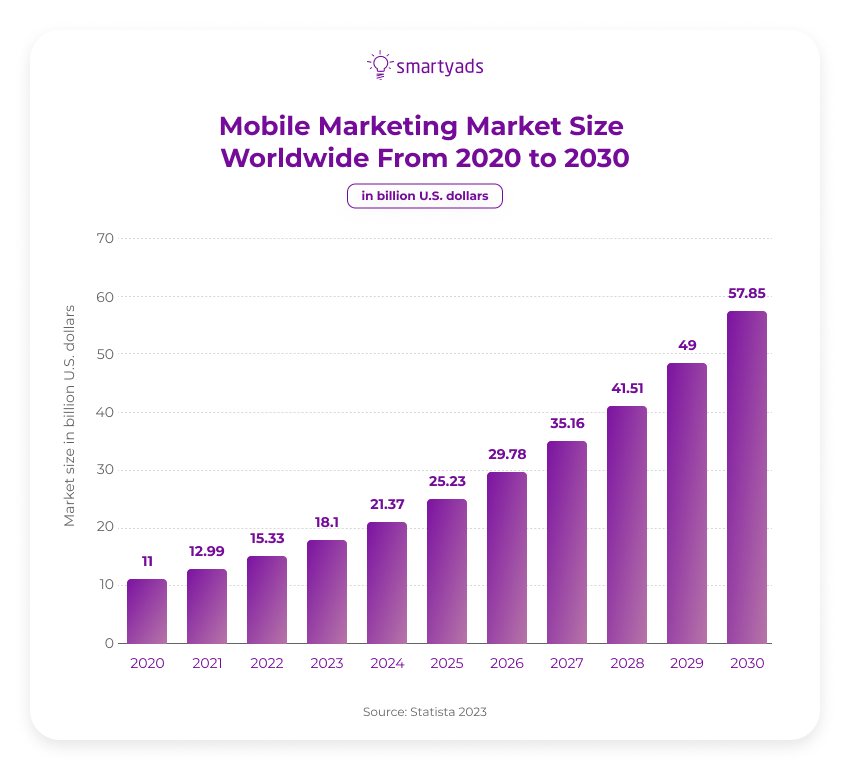
One of the main driving forces for the development of mobile marketing is, of course, mobile banner ads. In this article, we will explore what mobile banner ads are, their advantages and disadvantages, and how to run and customize them so that they show the desired results.

What are mobile banner ads?
These images can be seen in various sections of the mobile app and the web interface. Their placement is influenced by the dimensions of the banner, which can vary.
These banners come in static as well as animated forms. Stemming from the realm of desktop computers, this advertising format is among the earliest. Nonetheless, banner ads remain widely prevalent within mobile apps.
These ads often serve as a means for marketers and advertisers to promote products, services, or messages to a mobile audience.
They leverage the widespread use of mobile devices to reach users in various contexts, such as while using apps, browsing websites, or engaging with content. Mobile banner ads aim to attract users' attention, drive clicks and ultimately lead to desired actions such as visiting a website, making a purchase, or downloading an app.
Despite being one of the older formats of online advertising, mobile banner ads remain prevalent due to their adaptability and effectiveness in conveying messages to users on the go.
The most straightforward approach is to examine actual examples to grasp the concept of mobile banner ads and their functionality. These examples illustrate how a banner ad can engage potential customers and highlight current trends in the advertising landscape.
What benefits do mobile banner ads offer?
When coupled with precise targeting and compelling design, mobile banner ads emerge as an excellent advertising format, delivering extensive exposure while remaining budget-friendly.
The term "mobile banner ad" may sometimes carry negative connotations, particularly in the context of web or desktop interfaces, where the phenomenon of "banner blindness" can occur. This refers to the tendency of users to develop familiarity with banner ad placement and subsequently overlook them.
However, the occurrence of banner blindness can be mitigated. It predominantly affects uninteresting or irrelevant mobile banner ads that fail to align with users' interests and preferences.
Advantages of mobile banner ads for the advertiser:
The simplicity of the format translates to cost-effectiveness, demanding lower expenses compared to alternative options.
High visibility is a key feature, especially with full-screen banners. Moreover, the issue of "banner blindness" is largely absent in the case of full-screen banners, given their singular appearance on the screen.
Geo-location Targeting. Mobile ads can utilize location data to provide localized content, promotions, and directions to nearby stores, enhancing the effectiveness of location-based marketing.
Instantaneous Impact. Mobile ads reach users on their personal devices, enabling advertisers to engage users in real time, such as during specific events, promotions, or time-sensitive offers.
Rich Media Formats. Advertisers can leverage multimedia elements like images, videos, and animations in mobile ads, leading to more visually captivating and compelling content.
Measurable Results. Mobile advertising platforms provide detailed analytics, allowing advertisers to track impressions, clicks, conversions, and other key performance indicators in real time.
Cost-Effective. Mobile ads often have lower production costs than traditional advertising mediums, enabling advertisers to stretch their budgets further.
Flexibility in Ad Formats. Mobile ads come in various formats, including banner ads, interstitial ads, video ads, and native ads, offering advertisers the flexibility to choose the most suitable format for their campaign goals.
Social Media Integration. Mobile ads can seamlessly integrate with popular social media platforms, enabling advertisers to tap into the massive user bases of these platforms for targeted campaigns.
Data-Driven Insights. Mobile advertising platforms gather user data, enabling advertisers to refine their strategies based on user behavior and preferences, leading to more effective campaigns.
Drawbacks of mobile banner ads for the advertiser:
Limited Screen Real Estate. Mobile devices have smaller screens than desktops, which can restrict the amount of content and details conveyed effectively within a mobile ad.
Ad Blocking. Many users employ ad blockers on their mobile devices, reducing the visibility and reach of mobile ads and potentially diminishing the return on investment for advertisers.
Ad Fatigue. Frequent exposure to mobile ads can lead to ad fatigue, causing users to become unresponsive or even irritated by repetitive messaging, thus reducing the effectiveness of the ads.
Higher Click Fraud Risk. Mobile ads can be more susceptible to click fraud, where automated bots or unethical practices artificially inflate click-through rates, leading to wasted advertising budgets.
Advantages of mobile banner ads for the publisher:
Banner ads offer an excellent avenue for monetization, particularly advantageous for free applications. This approach finds exceptional effectiveness within gaming, social media, and service-oriented apps.
Diverse Ad Formats. Mobile banner ads come in various formats, allowing publishers to choose options that seamlessly integrate with their content, enhancing user experience and engagement.
Targeted Content. Mobile banner ads can be tailored to align with the interests and preferences of the publisher's audience, resulting in more relevant and engaging ad placements.
Increased User Engagement. Well-integrated and relevant mobile ads can enhance user engagement by offering additional content or promotions that align with the user's interests.
Enhanced App Monetization. For app developers, integrating mobile ads can provide an alternative to upfront app purchase costs, enabling wider app distribution and potentially attracting more users.
Cross-Promotion. Publishers with multiple apps or platforms can use mobile ads to cross-promote their own products, services, or content, effectively leveraging their existing user base.
Data-Driven Insights. Mobile ad platforms often provide publishers with insights into user behavior, helping them understand their audience better and refine their content strategy.
Audience Expansion. Partnering with mobile ad networks or advertisers can introduce a publisher's content to new audiences, expanding their reach and potentially attracting new users.
Cost Savings. By incorporating mobile ads, publishers can offset some operational costs associated with app development, maintenance, and content creation.
Flexible Integration. Mobile ad platforms offer various integration options, allowing publishers to seamlessly incorporate ads into their content, preserving the overall user experience.
Drawbacks of mobile banner ads for the publisher:
User Experience Concerns. Poorly designed or intrusive mobile banner ads can negatively impact the user experience, leading to user dissatisfaction and potentially driving users away from the app or website.
Ad Blocking. Users increasingly employ ad blockers on mobile devices, leading to reduced ad visibility and revenue generation for publishers.
Ad Fatigue. Overloading users with excessive ads can lead to ad fatigue, causing users to become disengaged and potentially diminishing the overall user experience.
Technical Challenges. Integrating and maintaining mobile ads within apps or websites can be technically complex, requiring ongoing attention to ensure smooth functionality.
Balancing Content and Ads. Striking the right balance between content and ads is crucial. Overloading with ads might overshadow the core content and result in decreased user engagement.

Mobile banner ad types
It would seem that "mobile banner advertising" is a type of advertising by itself. However, to think so is a big misconception. There are many mobile banner ad formats and types; many of them can be related to other types of advertising, and some are unique types that are not repeated for any other format. Let's take a look at them.
Standard Mobile Banners
These are the most common and recognizable mobile banner ad types. They typically appear at the top or bottom of a mobile app or website interface. Standard banners come in various sizes, such as 320x50 pixels or 300x250 pixels. While they may have limited space for content, they are still effective in conveying brief messages or brand exposure.
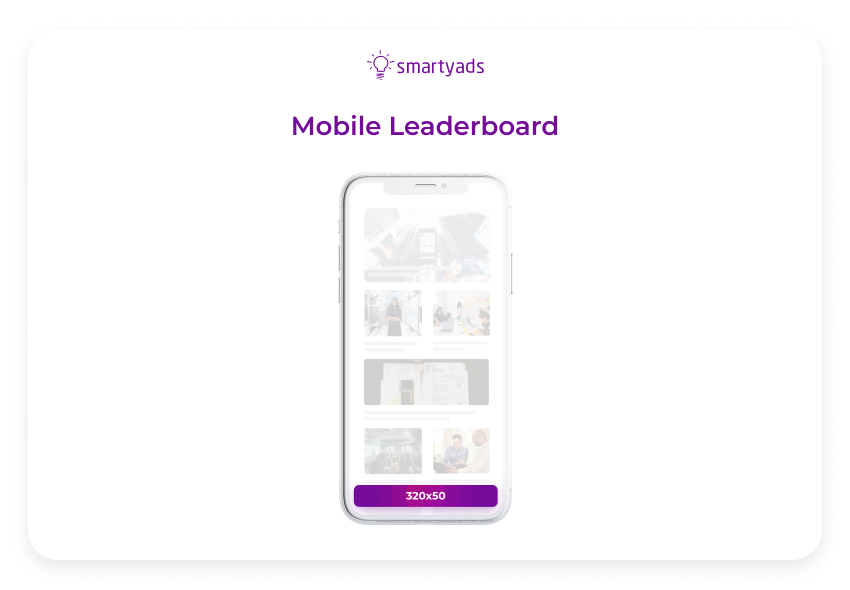
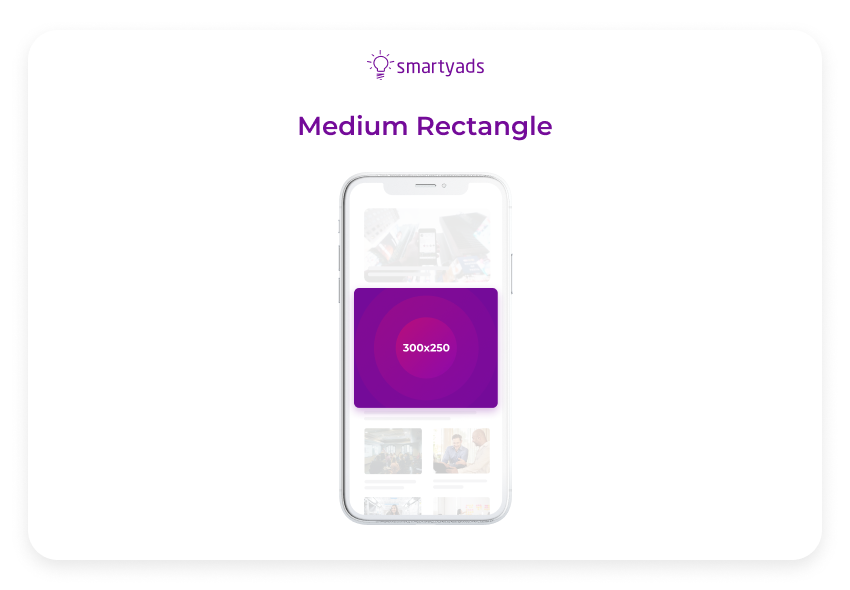
Interstitial Ads
Interstitial ads are full-screen ads that appear at natural transition points within an app or website. They often pop up between game levels, during app launches, or when users navigate between different sections. This is one of the most common mobile banner ad types in mobile apps. Due to their larger size and immersive nature, interstitial ads provide advertisers with more real estate to showcase their products or services.
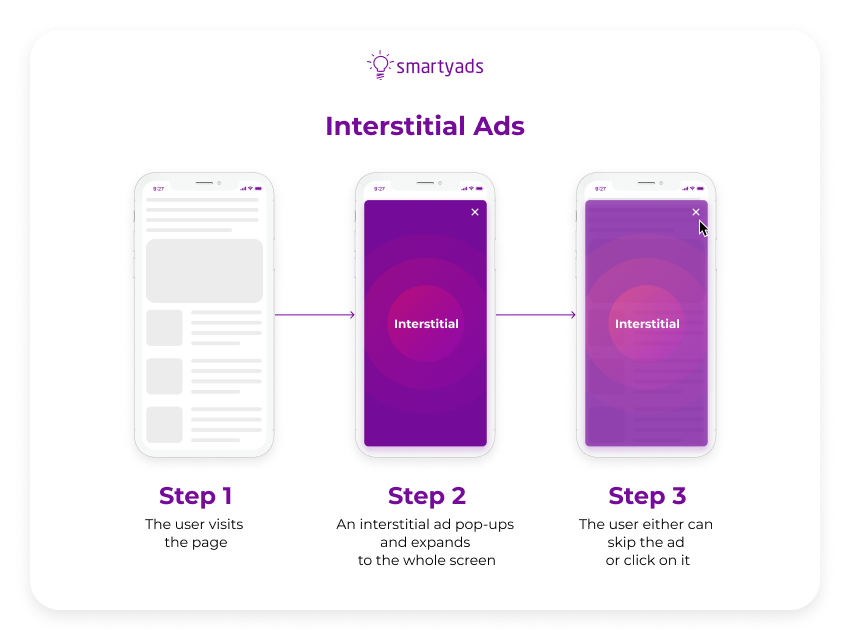
Expandable Banner Ads
These banners start as compact but expand to larger sizes when clicked or interacted with. This interactive mobile banner ad format enables advertisers to include more information, images, or even interactive elements, all within the same ad space.
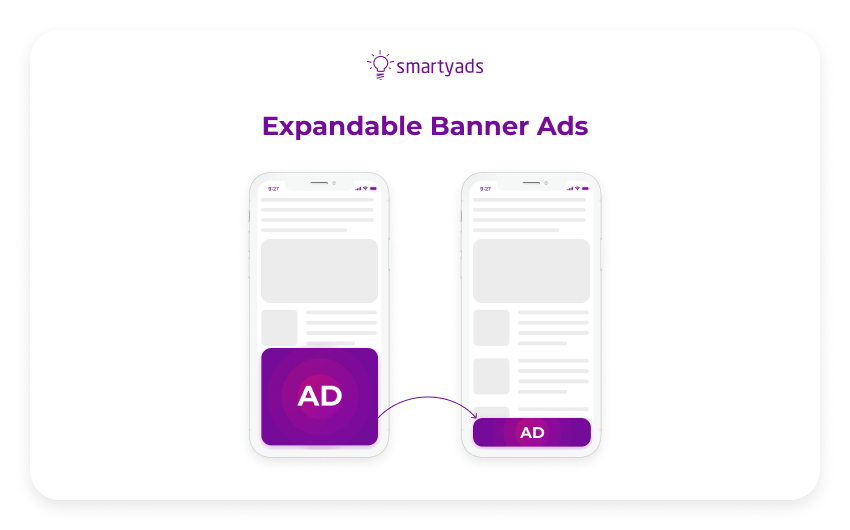
Video Banner Ads
Video banners prominently feature a video component. Video ads can automatically play when the mobile banner ad comes into view or requires user interaction to initiate playback. Video banners are effective for conveying dynamic content, storytelling, and showcasing products or services in action.
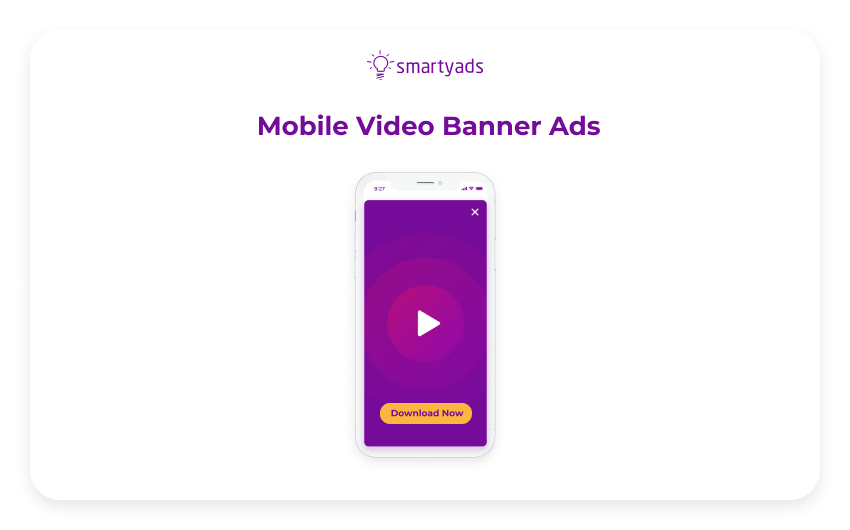
Swipeable Banner Ads
Swipeable banners allow users to swipe through multiple screens or images within the same ad space. This format enables advertisers to tell a more detailed story, display a range of products, or provide step-by-step information in a visually appealing manner.

Dynamic Banner Ads
These smart banners are personalized to the individual user based on their behavior, preferences, or location. Dynamic banners can significantly enhance engagement and drive conversions by displaying content that's relevant to each user.
Floating Banner Ads
Floating banners stay fixed on the screen as users scroll through an app or website. This ensures that the ad remains visible at all times, making it a good option for maintaining consistent brand exposure.
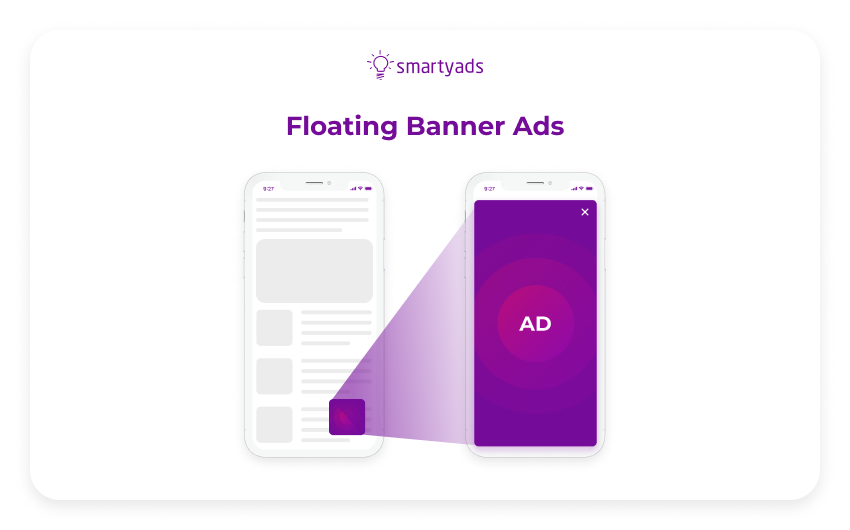
Banner Ads with Call-to-Action (CTA)
To be honest, almost every mobile banner ad now has a call-to-action; however, some put them in a separate category. Banner ads with a clear and compelling call-to-action (CTA) button prompt users to take a specific action, such as downloading an app, visiting a website, or making a purchase. This format can lead to higher click-through rates and conversions.
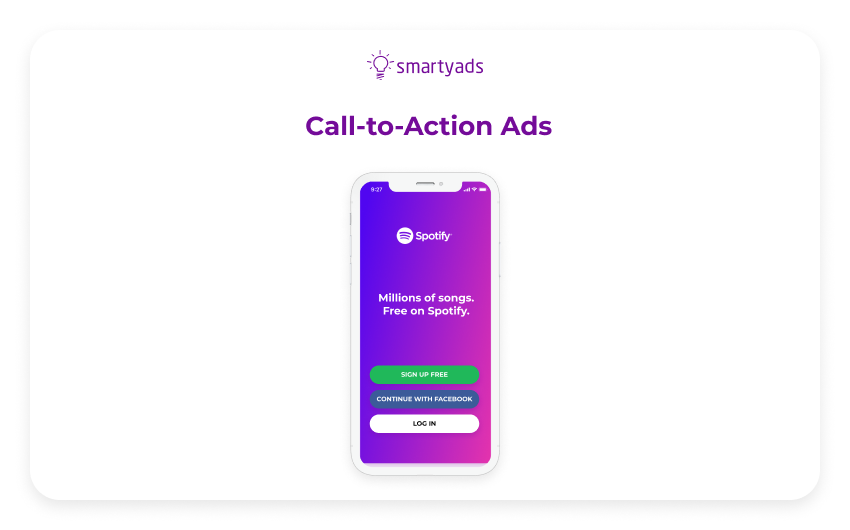
Native Banner Ads
Native banner ads seamlessly blend with the app or website's content, resembling natural elements of the platform. They're less intrusive and more likely to be perceived positively by users, as they fit in with the overall user experience.
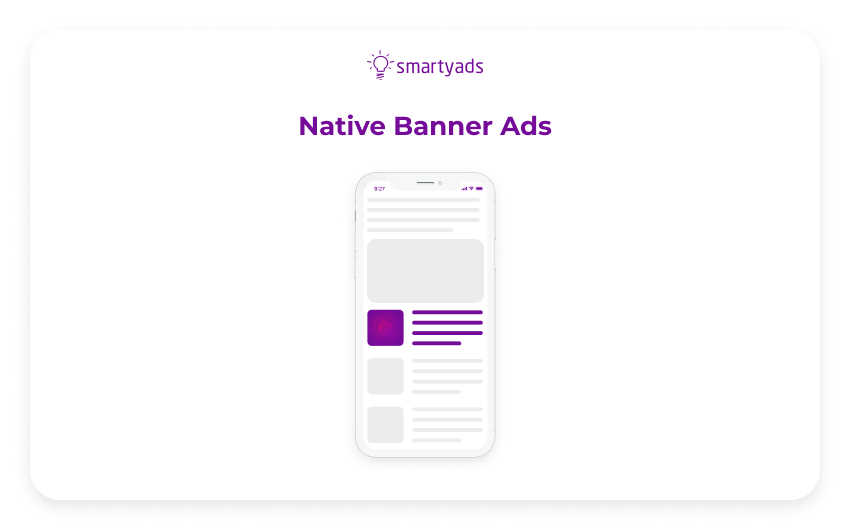
Animated Banner Ads
Animated banners incorporate subtle animations or movement to capture users' attention and convey information more effectively. These animations can be used to highlight key features, demonstrate product usage, or create visual interest.
GIF Banner Ads
Similar to animated banners, GIF banners use looping GIF images to introduce movement and visual appeal. GIFs can be particularly effective for showcasing product variations or demonstrating quick processes.
Bottom Sheet Banner Ads
These ads appear as a sheet rising from the bottom of the screen, providing additional information or a CTA. They're less intrusive than full-screen interstitials while still being attention-grabbing.
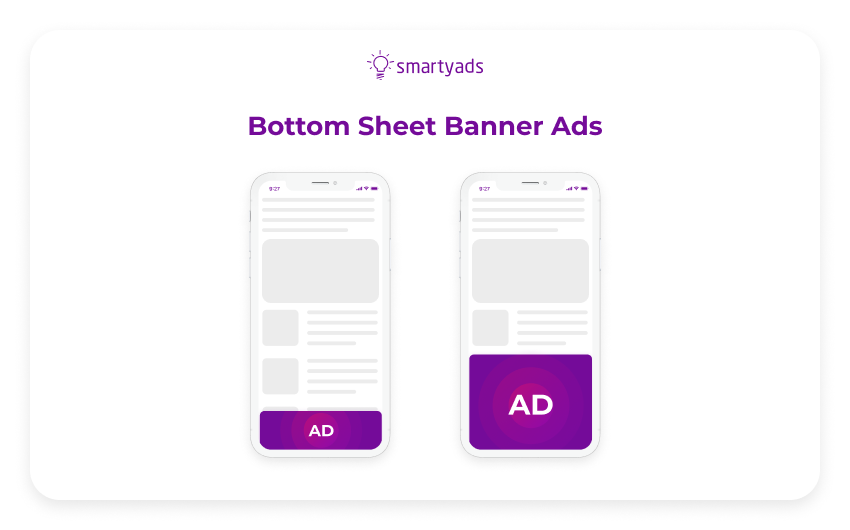
Mobile banner ad sizes
Mobile banner ad sizes vary to suit different display scenarios. In fact, there are so many mobile banner ad sizes that we even wrote a separate article about them. Advertisers leverage these dimensions to accommodate a range of screen spaces and optimize user engagement. Here's an overview of common mobile banner ad sizes and their typical placements:
Mobile banner ads exist in compact sizes, such as the standard banner ad, which discreetly sits at the top or bottom of screens. Larger dimensions, like the medium rectangle, seamlessly integrate within content, offering room for visuals and concise text. The leaderboard spans the screen's width, often finding placement at the screen's extremities.
For more impact, the large mobile banner ad, with its broader width, complements screen edges without overshadowing content. Meanwhile, mobile interstitials capitalize on full-screen transitions during app launches or level changes.
The square size, adaptable for in-content or edge placement, provides balanced visibility. Conversely, the button remains subtle yet effective for app interface calls-to-action.
Smaller variations, such as the small square and rectangle, cater to restricted spaces while conveying focused messages. The half-page ad, tall and narrow, targets specific devices and placements.
Each ad size accommodates diverse contexts, harmonizing user experience and message delivery.
How to create effective mobile display advertising
Creating good mobile display ads requires a lot of strategic decisions that will lead you to the desired result. In addition, the tips we will discuss below will help you create quality samples of any type of advertising.
Choose the right advertising platform
To accurately and competently customize your ads, you will need a tool that will allow you to perform all the necessary manipulations with the precision you desire. Nowadays, the most commonly used platforms for setting up digital advertising are programmatic platforms, such as SmartyAds DSP, which allow you to set up, analyze, and test multiple mobile ad campaigns from one place.
Define Your Objectives
Clearly outline your campaign goals. Are you aiming for brand awareness, driving traffic, promoting a product, or generating leads? Your objectives will guide the entire creative process.
Know Your Audience
Understand your target audience's preferences, behaviors, and needs. Tailor your message to resonate with them.
Choose the Right Ad Size
Select an ad size that fits the platform and placement. Consider where your ad will be displayed and design accordingly.
Craft a Compelling Message
Your message should be concise and impactful. Use clear, persuasive language that communicates the value of your product or service.
Design for Mobile
Mobile screens are smaller, so prioritize visual clarity. Use legible fonts, high-quality images, and minimal text for mobile banner design to ensure your message is easy to read.
Create Eye-Catching Visuals
Use attention-grabbing images or graphics that relate to your message. Visuals should be relevant and aligned with your brand identity.
Incorporate a Strong Call-to-Action (CTA)
Your CTA should be clear and actionable. Encourage users to take the desired action, whether it's clicking, downloading, or purchasing.
Optimize Load Times
Mobile users have little patience for slow-loading ads. Ensure your ad loads quickly to prevent users from clicking away.
Keep it Simple
Mobile banners have limited space. Focus on one key message or offer to avoid overwhelming users with information.
Utilize Animation Wisely
If using animations, keep them subtle and purposeful. Animations can help draw attention and provide a dynamic element to your ad.
Ensure Responsiveness
Test your ad on different devices and screen sizes to ensure it's responsive and looks good on all screens.
A/B Testing
Create multiple versions of your ad and conduct A/B testing to determine which performs best. Test different headlines, visuals, CTAs, and colors.
Landing Page Optimization
Ensure that the landing page your ad leads to is relevant, mobile-friendly, and provides a seamless user experience.
Track and Analyze
Use analytics to track the performance of your mobile banner ads. Monitor metrics such as click-through rates (CTR), conversions, and engagement to refine your approach.
Continuously Improve
Based on your analytics, make iterative improvements to your ads. Learn from what works and what doesn't, and refine your strategy accordingly.
Conclusion
Experts within the industry firmly believe that leveraging mobile devices and applications for advertising is the most reliable strategy to monetize websites and free mobile apps.
This ad format offers a safeguard against risks: even if your app experiences a drop in its store ranking or a decrease in new user acquisition, revenue generation remains intact.
Effective mobile app advertising works uniformly well for apps with high daily session durations and sporadic use. The key lies in selecting the appropriate size, format, and placement of the mobile ad unit.
However, the choice of a mobile ad format is merely one aspect of the equation for achieving successful in-app campaigns. The ultimate outcomes significantly hinge upon precise targeting configurations, selecting the right ad platform, ad network, and other various pivotal elements.
By the way, we remind you that you can run any banner ads with SmartyAds DSP.

